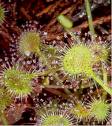Herb Information - Sundew
Drosera rotundifolia Droseraceae A small aquatic plant, sundew is now rare in the UK. It can be seen in damp peaty areas, especially in Wales, in summer. The plant eats imects. The leaves, which lie flat on the ground, are covered in fine, red, insect-trapping sticky hairs. Each hair is tipped with a small flllid-jilled gland that looks like a dewdrop, hence the plant's name. Parts used
ConstituentsSundew contains naphthaquinones, including an antibacterial and antispasmodic called plumbagin. It also contains flavonoids that improve the circulation by strengthening blood vessels, astringent tannins, which have antioxidant, antibacterial and anti-inflammatory properties, and mucilage - which soothes inflamed mucous membranes. Medicinal usesSundew tea has long been used in European traditional medicine to treat lung ailments and dry coughs.áThe main active constituent in sundew is a compound called plumbagin, which has an antispasmodic effect, particularly in the respiratory and intestinal tracts. This effect was demonstrated by Swiss research conducted in 1993. The herb also exerts soothing and expectorant actions, and sundew is prescribed to treat respiratory tract illnesses such as bronchitis and pertussis (whooping cough), dry, tickly or nervous coughs and other respiratory conditions that cause the production of sticky mucus. It is often combined in syrups with other cough remedies such as thyme. The usefulness of sundew in treating chest infections is reinforced by the fact that plumbagin inhibits the proliferation of germs such as ~ streptococcus. staphylococcus and pneumococcus, as well as certain disease-causing fungi.Externally, the juice of the raw. untreated plant has been used as an effective treatment for warts. CAUTIONS
PREPARATION AND DOSAGEFor internal use TO TREAT bronchitis, dry, tickly or nervous coughs. whooping cough For external use TO TREAT warts IF SYMPTOMS PERSIST CONSULT A DOCTOR CultivationSundew can be cultivated from seed but needs to be planted in wet peat in a spot that receives full sunshine. |
´╗┐
Ayurveda Book
This book on Ayurveda is meant for people interested to know about basics concepts of Ayurvedic healing and learn ayurveda concepts. Though there are many books Read More My SitesReal Testimonials
Connect with us |







